Top 10 Patterns from the Potomac River
What got it done on a stingy August bite
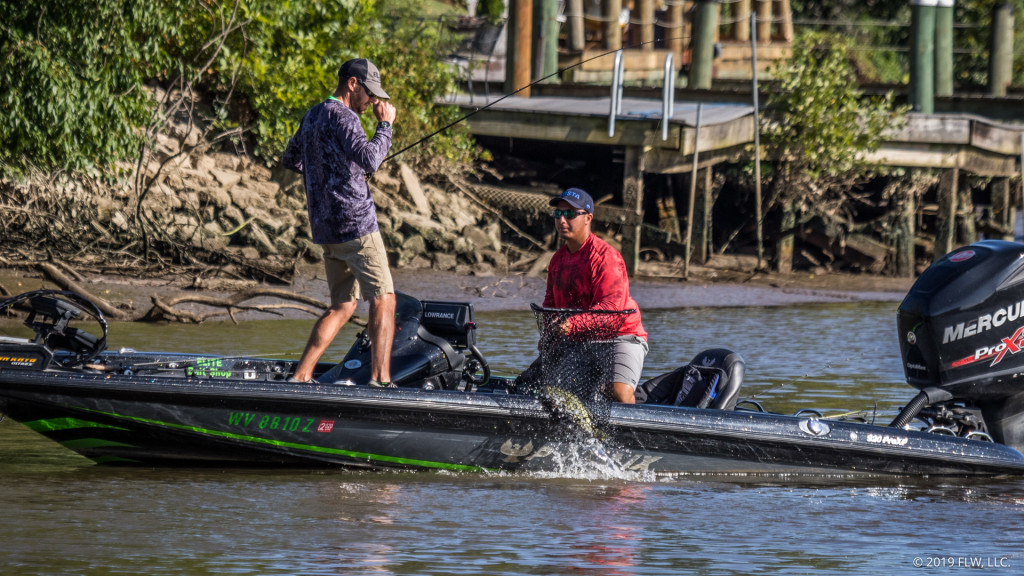
The Costa FLW Series Northern Division presented by Gajo Baits event on the Potomac River was not the slugfest the season opener on Champlain was or the season finale on the St. Lawrence River is almost sure to be. As has been the case in many of the FLW events on the Potomac this year, the fishing was pretty stingy, and hard cover played an outsized role.
Taking the win in wire-to-wire fashion in the second stop of the season, which was presented by Lowrance, Marvin Reese fished hard stuff up by Washington, D.C., but only managed four fish on the final day, turning what could have been a runaway into a nail-biter. Low weights across the board also gave folks a lot of opportunity to move up and down quickly, as evidenced by Troy Morrow’s surge from 10th to second and Adrian Avena’s jump from ninth to fifth.
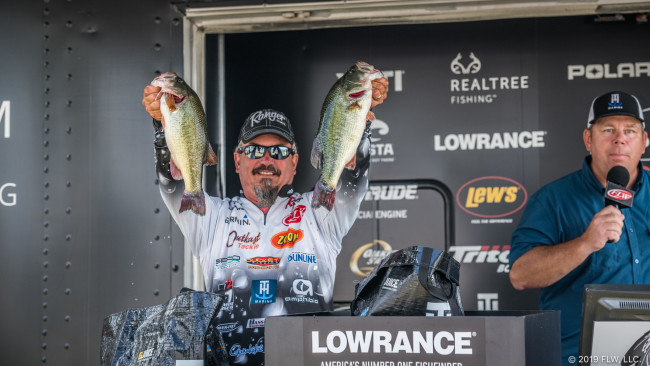
2. Morrow surges on the final day
Catching 14-7 on the final day, Troy Morrow could have won the event with a little more consistency. Mixing both grass and hard cover, Morrow nearly put together the winning combination.
“It happened because of all three days,” says Morrow. “I elected to fish grass on the first day, it’s all I fished, and I fished nothing but two different Speed Worms, and I had five keeper bites all day and one was a 5-pounder.”
On day two, figuring he needed more bites, Morrow went north and fished hard cover. That worked, but he changed up for day three.
“I elected to combine the two,” says Morrow of his final day. “The quality bites seemed like they were coming from the grass, but the numbers were coming from the hard targets. I went to the hard targets first to get my limit, and actually lost the winning fish doing that, and then went to grass at the end and made my last cull.”
Fishing the hard stuff, Morrow relied on a Zoom WEC E1 crankbait, a moccasin blue-colored wacky rig on a 1/8-ounce Gamakatsu G-Finesse Series Wacky Jig Head and a drop-shot with a Zoom U Tail Worm and a 1/0 G-Finesse Series Light Worm Hook. For both finesse baits, Morrow used braid with a 10-pound Sunline leader.
For his grass bite, Morrow targeted stretches and clumps that were submerged and off the main hydrilla edge. Ideally, he had his boat in about 4-feet of water and could still reach the topped-out grass edge with a cast. Though most of the grass was hydrilla, he says some clumps of star grass were mixed in. Fishing in Mattawoman Creek and south of there, the fish chewed for him on the final day.
In the grass, he plied a Zoom Speed Worm with a cut tail in moccasin blue as well as a Zoom UltraVibe Speed Worm in watermelon moondust. He rigged both on a Gamakatsu Superline EWG hook, with 16- and 20-pound-test Sunline fluorocarbon and a pegged 3/16-ounce weight.
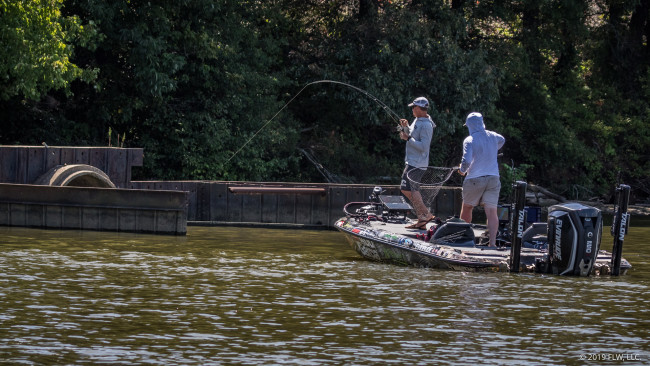
3. Atkins leans on a drop-shot
Sticking in second until the final day, Justin Atkins weighed a total of 37-3, but saw his weights decline each day.
Atkins fished a handful of different places with water running into the river, some main-river rock, and the grass bed south of Pomonkey Creek. He mixed a few other baits in, but leaned hard on a drop-shot.
“It went really good,” says Atkins of his event. “I learned last time here in August that the fish aren’t biting everywhere. This week I spent a lot of time with the trolling motor down paying attention to where I got bites and I found three or four areas, one main grass area and three or four places that were current-driven areas, that had bites and I just spent my time casting in ‘em.”
Atkins’ main bait, in grass or current, was a drop-shot with a fat 4 1/2-inch hand-poured worm. On the first two days he always stuck with an 8-pound Berkley Trilene 100% Fluorocarbon leader and a 3/16-ounce weight, but he dropped to a 1/8-ounce weight on the final day in the grass.
In thicker cover he also employed a popping frog and a Berkley PowerBait Bunker Hawg on a big weight. In some of his current spots, particularly in one with clear water, he tossed a weightless Texas-rigged 4-inch Berkley PowerBait MaxScent The General.
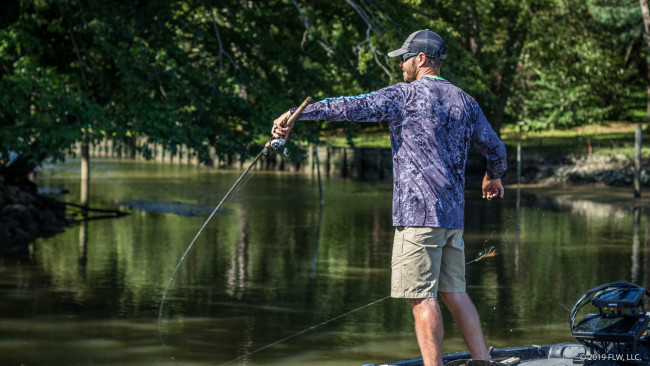
4. Davidson mines one creek
Little Hunting Creek was the primary home for Ryan Davidson on the week, and depending on the conditions he adjusted his approach to put big numbers in the boat every day.
“I was targeting the pads when you could get a high tide that was outgoing, those big fish would be in the drains of the pads,” says Davidson. “That was how you could get a quality bite, but the tide was never right for doing that. It was good numbers on low tide, but the quality was a little better on high tide and I could catch them just as good. On low tide it was the outside of trees and dock poles, and on high tide they would put their nose right on the bank, in 6-inches of water.”
Davidson figures he caught 30 keepers out of his creek on day one, 20 keepers on day two and another 15 keepers or so on the final day. In the creek, his main baits were a homemade balsa crankbait and two jigs: a Missile Jigs Mini Flip and a Strike King Fluorocarbon Flipping Jig. With both jigs, he used a 3/8-ounce model with a green pumpkin skirt and a Zoom Z Craw Jr. in Cajun craw for a trailer.
Davidson also punched some mats in Mattawoman with a YUM Bad Mamma in black blue shadow. On day one, he managed to cull twice in the mats, but the rain killed that on day two and wind and waves had muddied the area up on the final day.
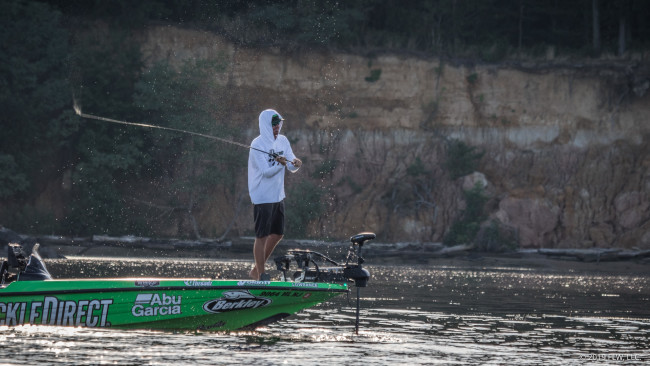
5. Mixed bag works for Avena
Notching his third FLW top 10 on the Potomac River, Adrian Avena’s weight got better each day as he kept practicing and hunting for better fish. Bringing his john boat to practice out of instead of his wrapped bass boat let Avena be stealthy in practice, but it also limited his ability to see everything.
“I fished pretty much the whole river,” says Avena. “I have a little history here, and I tried to cover as much as I can, and in two and a half days in a john boat you can’t cover it. I basically spent the duration of the tournament practicing too, trying to just look for those better-than-average bites.
“Whenever I come here I try to keep an open mind,” he says. “The first day I caught them local, the second day I ran way south, and [the final day] I caught some local and then I ran way north. It was all over the place, and I never really found what I wanted to, so I just kept looking.”
Part of Avena’s rationale for bringing the john boat in practice was that he’d be able to sneak into the backs of creeks more easily, but that turned out to not really be the deal. Instead, Avena flipped some matted grass with a Berkley PowerBait Chigger Craw with a 1 1/4-ounce weight and fished pads, creeks, wood and other targets with a ¼-ounce black buzzbait with a 3-inch Berkley PowerBait Pit Boss for a trailer.

6. Hard stuff is the deal for Grike
Robert Grike has a reputation as one of the best hard-cover anglers on the Potomac, and he almost went all the way this week. Weighing just four fish on the final day, Grike had his shots at the win.
“One thing I learned from [Sunday] is that the fish are used to seeing what I throw at them,” says Grike, who fished with winning co-angler Jim Short. “I had a slick fisherman [on the final day] who knew what he was doing, and he caught that key 5-pounder, and my bait was in there, I could have caught that fish had I been throwing the right thing. But I think they’re used to seeing my lures.”
Fishing up north most of the tournament, Grike flipped a Cheeseburger Robert jig with a Missile Baits Craw Father for a trailer, mixed a drop-shot in some and also used a blue fleck-colored Berkley Power Worm.
Grike never had trouble getting a limit on the first two days, but in trying to make up a deficit on the final day, he specifically sought out big fish.
“I really swung for the fence,” says Grike. “I fell a little short, but I’d do it again.”

7. Thompkins power-fishes hard cover
Growing up near Winyah Bay, 17-year-old Jordan Thompkins says he’s well-versed in tidal waters and docks. That came in handy this week on the Potomac.
“Hard cover, rocks, docks, and then I had one area with some grass,” says Thompkins of his targets. “There was gizzard shad around the grass spot, and I think the little bit better fish were feeding around them. There weren’t many of them, but there was good ones.”
Unfortunately for Thompkins, his grass spot seemed to be worth about a fish a day, and nothing on the final day. He also couldn’t get into one of the two creeks he was fishing hard cover in, so he spent most of the final day in Little Hunting, fishing below Davidson. There, he threw around a squarebill and a vibrating jig for the most part, preferring to keep on the move rather than flip targets.
Fishing just his second FLW Series event as a boater, he earned his second FLW top 10.
“It feels pretty good,” says Thompkins of his performance. “I’m still in high school, so I’ve got a long way to go I guess.”
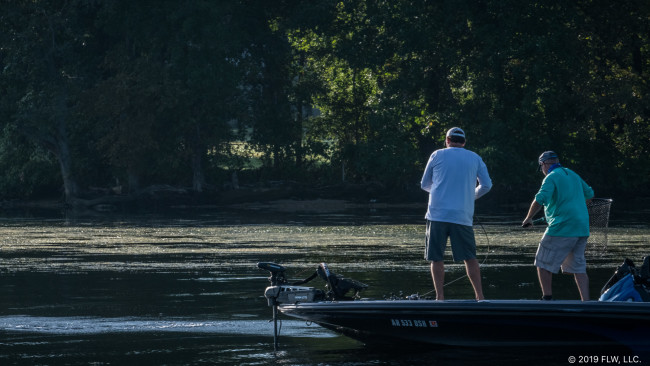
8. Hays camps out in Chicamuxen Creek
Working an XCalibur Zell Pop or a weightless Zoom Fluke Stick, Dylan Hays caught limits on the first two days but came up short on the final day.
“I caught probably 90 percent of them on the Zell Pop, almost all of them first thing in the morning, in the first hour,” says Hays. “I culled three times in the afternoon on day two, I sight-fished one of them, and then it got rainy and I started just blind-casting the Fluke Stick.”
On day three, Hays caught his fish on a mix of the popper and the Fluke Stick, but the bright conditions seemed to limit his bite. Every fish he weighed came from Chicamuxen, but he didn’t plan that at the beginning of the event.
“The first day I had a limit by 8 o’clock, so I left and flipped wood all day and never had a bite,” says Hays. “The second day I decided to stay the whole time, and it worked, and [Sunday] I didn’t have anywhere else to go, so I stayed. I’m not mad about it, I caught five keepers in practice in four days, so this is good.”
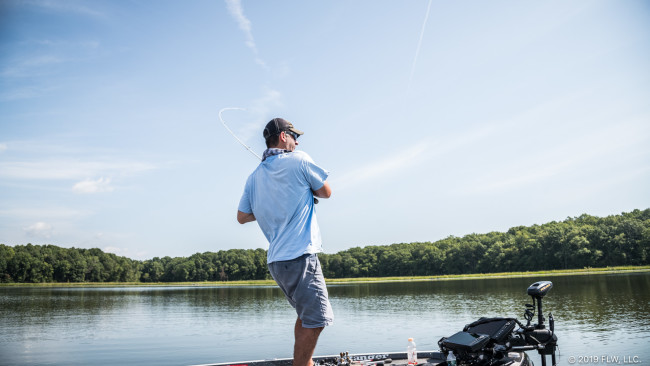
9. Senko is all Smith needs
Putting up his second consecutive top 10, Casey Smith moved into a three-way tie with Morrow and Avena for second place in the Angler of the Year race behind Scott Dobson.
Smith has never finished outside of the top 18 in the Northern Division points, and he’d really like to take home the AOY title.
“That’s why I come to these,” says Smith, who lives in Macedon, N.Y. “I think that title holds a lot of weight, and I think a lot of the guy that wins it every year. It’s extremely difficult to do in the Northern Division, with how consistent the weights are over the year. I’ve been close two or three times, so it’ll be on my mind a lot. I’m looking forward to it.”
As for the actual Potomac fishing, it was about as boring as it gets – Smith threw a weightless Yamamoto Senko on one stretch of grass in Aquia Creek for three days in a row.
“I don’t fully understand the tides, so I don’t even attempt to run them,” says Smith. “The way I treat it here, is I hunker down in my best area. So, I pick the best of what I’ve got, wait out the dead periods and try to capitalize on bite windows.
“It was the most boring fishing,” says Smith. “I honestly thought about telling [tournament director Mark McWha] that I’d take 11th place and go home so I didn’t have to go back out there again.”

10. Grass falls short for Dieffenbauch
Winding a homemade vibrating jig, Wil Dieffenbauch struggled on the final day.
Ringing in at 3/8 of an ounce, Dieffenbauch’s vibrating jig was green pumpkin, with some blue in it, and he trailed it with a watermelon red Zoom Salty Super Fluke with orange dye on the belly.
“I make it how I want it,” says the West Virginia angler of his bait. “I put a good hook in it, and I put the right keeper in it, so I can rip it out of the grass as hard as I want and be alright.”
Fishing mostly in Aquia, Belmont Bay and Mattawoman, Dieffenbauch was walking a tightrope every day.
“I was fishing submerged grass, mainly clumps, and I was just ripping that ChatterBait as hard as I could,” he says. “I really wasn’t on anything, it was all between 2 and 4 feet, and I just didn’t get the flurries I needed [Sunday].”